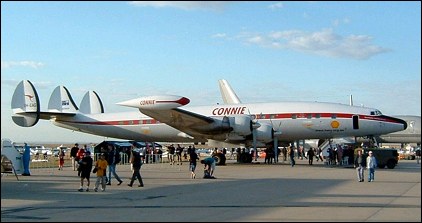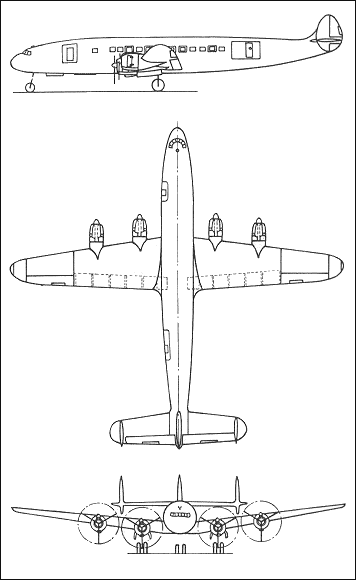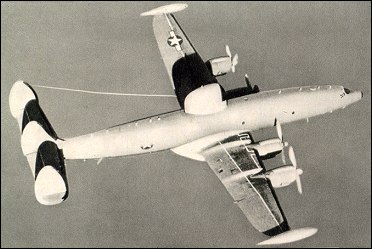|
| The next stage in development of the Constellation was the L-1049 Super Constellation with lengthened fuselage, strengthening for higher gross weight, increased fuel capacity and more powerful engines. The first prototype Super Constellation (a conversion of the original C-69 prototype) flew for the first time on 13 October 1950. First in commercial service (on 15 December 1951) was one owned by Eastern Air Lines. This version could accommodate 71 first-class or 95 coach-class passengers (14 delivered to Eastern and ten to TWA during 1951-52). A number of improved variants followed - the last and most important being the L-1649A Starliner, regarded as the ultimate development of the piston-engined civil airliner.
L-1049 Super Constellation were in use by both the USAF and US Navy under a variety of C-121 and R7V designations respectively.
| MODEL | L-1049G |
| CREW | 4 |
| PASSENGERS | 62-109 |
| ENGINE | 4 x 3400hp Wright R-3350-972T-C18DA-3 |
| WEIGHTS |
| Take-off weight | 4õ3400 kg | 9 lb |
| Empty weight | 33119 kg | 73015 lb |
| DIMENSIONS |
| Wingspan | 37.62 m | 123 ft 5 in |
| Length | 35.41 m | 116 ft 2 in |
| Height | 7.55 m | 25 ft 9 in |
| Wing area | 154.40 m2 | 1661.95 sq ft |
| PERFORMANCE |
| Cruise speed | 589 km/h | 366 mph |
| Ceiling | 6950 m | 22800 ft |
| Range | 6700 km | 4163 miles |
| Dale Mosher, e-mail, 26.08.2009 00:19 I flew more times than I wanted on this big vibrator. First landing in Iceland all I could see was us skidding down a slick runway in December (Keflavik). I filled in as ground crew to run up engines, crew chief engaged prop pitch and I almost got sliced and diced. I remember lots of fire and smoke at startup. Not really fond of the old birds! reply | | AHM FAN, e-mail, 20.04.2009 04:55 The Air Line History Museum has a L-1049G See their web site www.airlinehistorymuseum.com for more information. Its a great museum located in Kansas City, Missouri [USA] reply | | Michael Kelly, e-mail, 25.06.2008 00:47 Spent most of my 4 yr. tour in the USAF working the instrument systems on the EC-121. McClellan, Korat Thailand, Iceland, and back to McClellan. Had the dubious honor of getting wiped out by one of her massive props in Thailand (1970). Lots of fond memories though. reply | | Fred Snyder, CMSgt (ret) AST, e-mail, 10.06.2008 23:42 The RC-121(later EC)came into the US Air Force in 1954. Two Wings, at McClellan AFB, CA and Otis AFB, MA, one Sqdn at McCoy AFB,FL. 14 plus hour surveillance missions were normal. Many TDY's, mostly in SEA and Iceland. US Navy version was the WV-2. Replaced by the E-3A AWACS in 1976. Visit www.aewa.org for more information. reply | |
| | Jerry Van Boxtel, e-mail, 29.05.2008 21:55 I was a flight engineer on the EC-121 connie in the nam war. We were flying recon missions, mostly in Laos. Pretty safe job as we were able to fly at 5000 feet due to the fact that we were using electrontc sensors to find the bad guys. Our biggest danger was flying in weather. We lost two crews due to this problem. We were constantly fighting iceing conditions as there were so many rain clouds at this altitude.The only other problem was the engine failure rate. We averaged 50 hours on and engine before it failed. So we were flying on 3 engines a lot of times.The reason for the low time to failure is these aircraft were taken out of mothballs and the engines didn't get a lot of attention before shipping. reply | | Lt/Col Lester Stilwell, USAF R, 29.04.2008 20:13 I have over 3,500 Hrs in the RC-121. Max Take Off Gross was 142,000 Lbs. I think the 1049 max Gross was 130,000 Lbs reply |
|
Do you have any comments?
|
| 
COMPANY
PROFILE
All the World's Rotorcraft
|








